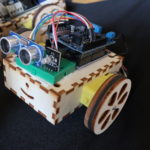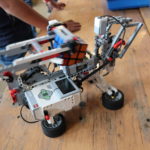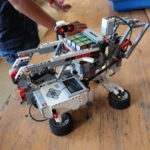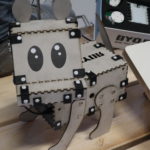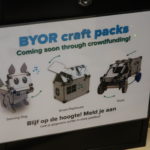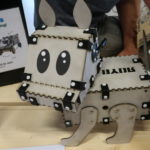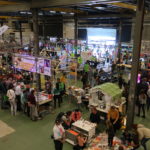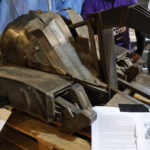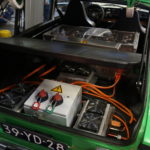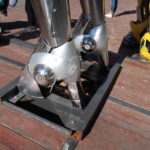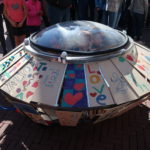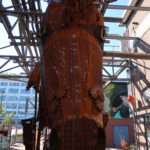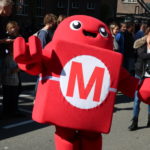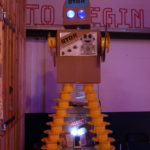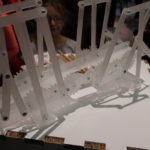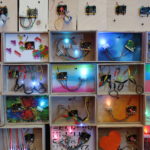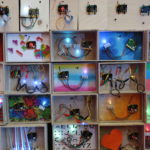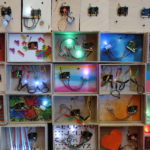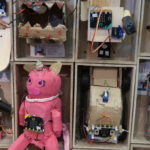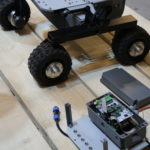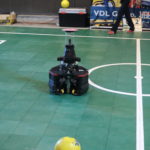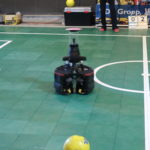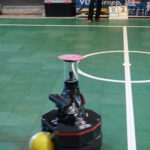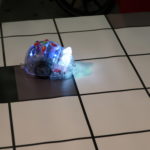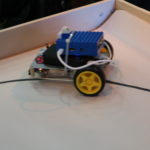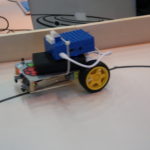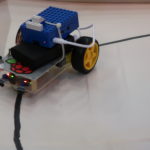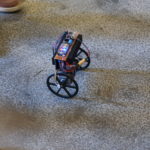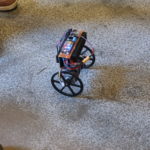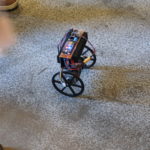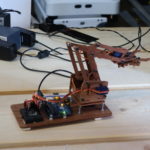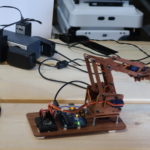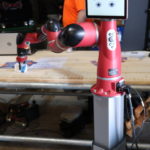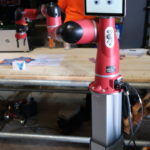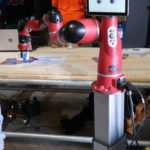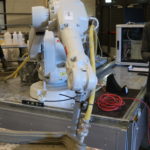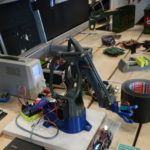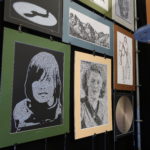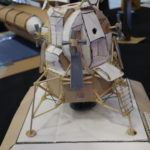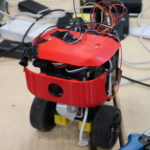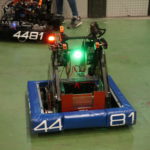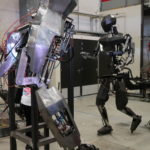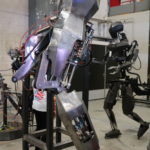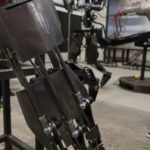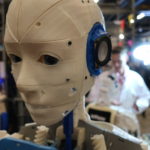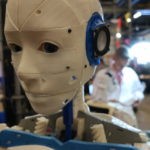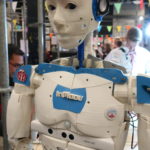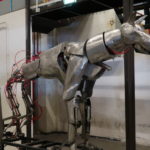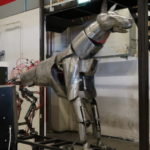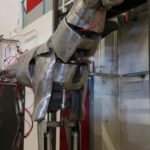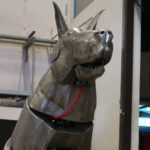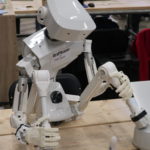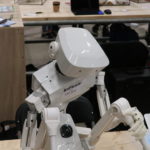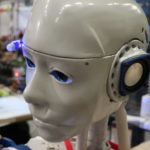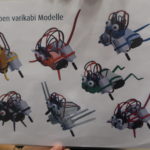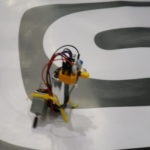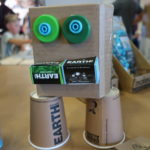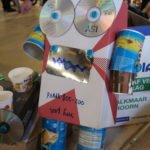Archiv der Kategorie: Development
World’s first smart dancing robot speaker, dancebot, gets funded just 2 hours from launch
Expressive robot speaker connects with any Bluetooth-capable device and converts any type of audio played in real time into motion using intelligent algorithm to drive the feet of the robot using bionics technology.
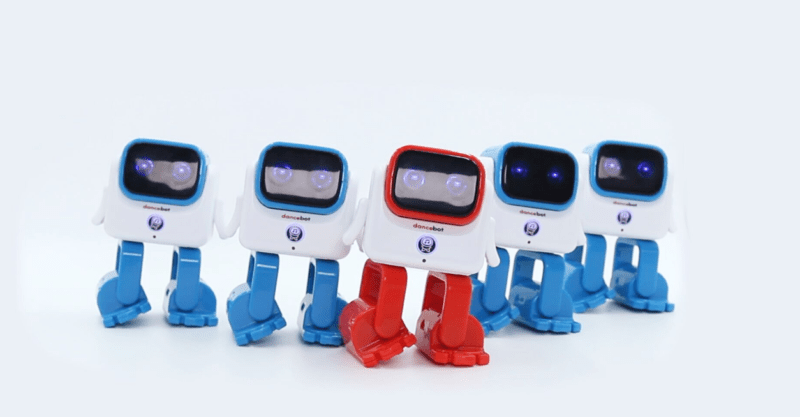
HOUSTON – Aplus Drones is pleased to announce the launch of Dancebot, a smart dancing robot speaker designed with intelligent algorithm technology, today on Kickstarter. Dancebot reached its funding goal of $10,000 in just 2 hours.
Dancebot is the world’s first smart dancing robot speaker. Connect your device to Dancebot via Bluetooth and use it as a speaker. Dancebot will move to the audio it plays.
Aplus Drones has developed an algorithm to analyse audio input on the fly to string together movements that best express the sound played through Dancebot. It moves to the rhythm and tempo of music in its adorable expression of the songs. It taps its feet and jives to upbeat tunes. It slides in silky sleek movements to bring out the sexy in slow pieces.
Dancebot is designed with two joints in each leg. A motor drives each joint through 360 degrees of motion. Aplus Drones engineers have been creating a database of movements Dancebot is capable of. The variation of speed and degree of motion at each joint creates multiple permutations of possible moves that can be achieved with the four joints. The large library of movements and on-the-fly analysis means Dancebot has a different dance routine each time it jives to the same song.
The movement expressed by Dancebot depends on the audio it plays. Besides playing music, Dancebot can be used to play audiobooks, videos, podcasts or even voice messages.
This makes Dancebot the perfect companion for children. Play a children’s audiobook or nursery rhymes with Dancebot and it will move to the narration of the story and dance along to the nursery rhymes. Dancebot’s animated movements makes learning more engaging and a whole a lot more fun.
The startup sound for Dancebot can be customized into a personalised message, making it ideal as a gift.
For more information or to purchase Dancebot at a special discount during crowdfunding, visit the Dancebot Kickstarter campaign page.
About Aplus Drones
Aplus Drones is an entrepreneurial technology company focusing on artificial intelligence and robotic technology development. The company provides award-winning product design, product development, manufacturing, marketing, logistics and shipping services. Full control over the whole supply chain makes Aplus a one-stop solution for clients.
About Dancebot
Dancebot is a smart dancing robot speaker that is a fun audio companion. It moves to the rhythm and tempo of the audio played through it. Play music, audiobooks, podcasts, videos or even voice messages
The Duckietown Foundation announces the AI Driving Olympics (AI-DO), a self-driving car competition to debut at NIPS 2018
The Duckietown Foundation is excited to announce the The AI Driving Olympics, a new competition focused around AI for self-driving cars. The first edition of the AI Driving Olympics 2018 will take place December 7, 2018, at Neural Information Processing Systems (NIPS), the premiere machine learning conference, in Montréal. This is the first competition with real robots that will take place at a machine learning conference.
The competition will use the Duckietown platform, a miniature self-driving car platform used for autonomy education and research. The Duckietown project originated at MIT in 2016 and is now used by many institutions worldwide.
The AI Driving Olympics is presented in collaboration with 6 academic institutions: ETH Zürich (Switzerland), Université de Montréal (Canada), National Chiao Tung University (Taiwan), Toyota Technological Institute at Chicago (USA), Tsinghua University (China) and Georgia Tech (USA), as well as two industry co-organizers: nuTonomy (a self-driving car company) and Amazon Web Services (AWS).
About the competition: The competition comprises 4 challenges of increasing complexity: 1) Road following on an empty road; 2) Road following with obstacles; 3) Point to point navigation in a city network with other vehicles; and 4) Fleet planning for a full autonomous mobility on demand system.
Competitors will have access to a suite of professional development tools (simulators, logs, baseline implementations). Real environments called “Robotariums” will be remotely accessible for evaluation. The highest scoring entries in the robotariums will be run during the live event at NIPS 2018 to determine the overall winners.
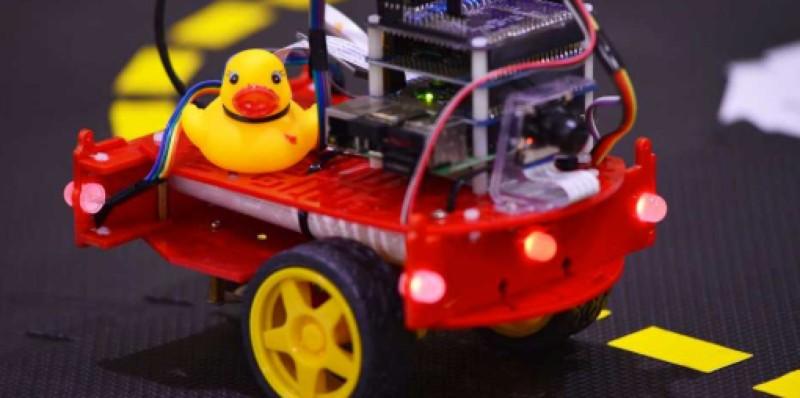
Scientific goals: The competition aims at directing academic research towards the hard problems of embodied AI, such as modularity of learning processes, and learning in simulation while deploying in reality.
Social goals: The competition also promotes the democratization of AI and robotics research by using an inexpensive platform, and offering a common infrastructure available through the use of remote testing facilities. Competitors can also build or acquire their own testing facility (Duckiebots and a Duckietowns), through either open-source DIY instructions, or as rewards obtained in our kickstarter campaign (https://www.kickstarter.com/projects/163162211/duckietown-a-playful-road-to-learning-robotics-and?ref=dwrnb2)
Transform your classroom with VEX EDR
Careers in STEM are on the rise!
Give your students the tools they need to succeed:
With more schools adopting robotics as a platform to enhance STEM and Computer Science courses, teachers need a solution to seamlessly integrate curriculum, programming software, and hardware into the classroom.

STEM Labs
Our scaffolded, standards-matched STEM Labs
can be adapted to fit any classroom
STEM Labs are hands-on activities, which include diverse builds, games, and competitions, that align with education standards while also showing real-world applications of concepts.
These activities give students the opportunity to communicate and collaborate with their classmates. Every STEM Lab has multiple approaches to solving a problem, allowing students to experiment with creative design solutions.
For many teachers, figuring out how to implement concepts into maths, design & technology, engineering and computer science subjects can be difficult. Our STEM Labs allow for easy implementation with minimal preparation time. Each STEM Lab can be used on multiple platforms and includes easy-to-follow build instructions.
MIMIC educational robots introduces robots you can code
Cincinnati-based Entrepreneur launches Kickstarter campaign to launch ‘mimicArm’, your own programmable A.I. robot arm

Cincinnati, OH (April 14, 2018) – mimicEducationalRobots (a division of Robomotive Laboratories LLC) is changing the way coding is taught with mimicArm. The Cincinnati-based small family business launched a new Kickstarter campaign (https://www.kickstarter.com/projects/713401305/662798422?ref=455790&token=e4d4249c) on April 24th to help advance the development and production of the new technology.
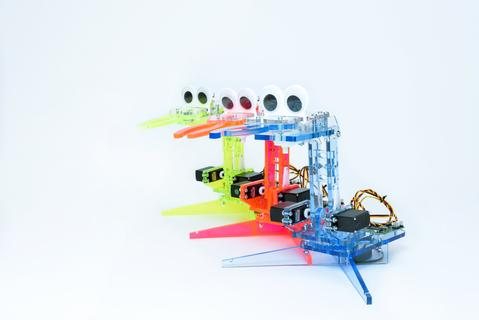
mimicArm is a desktop sized robot arm that represents a new approach to teaching programming. mimicArm is a collaborative robot, or “cobot”, designed to interact with human users. Unlike other educational robots mimicArm teaches children to program robots to work in tandem with humans. Using the mimicArm controller children as young as 5 are immediately able to interact with mimicArm. When they’re ready, users can begin coding using mimicBlock, a graphical coding interface. mimicArm is also programmable using actual C code and includes simple pre-written functions to allow the quick creation of complicated programs. The provided programming experiments start simple, but build to complex interactive artificial intelligence programs. Paired with the inputBox and other sensors the user can create a truly interactive artificial intelligence robot arm.
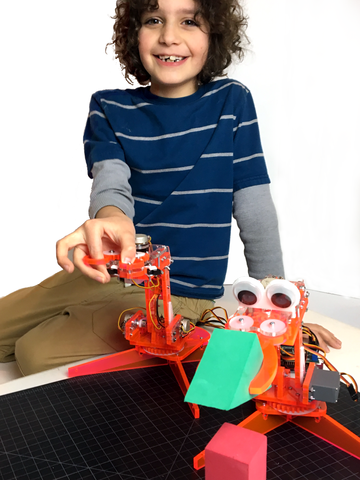
Brett Pipitone, the Founder of mimicEducationalRobots is no stranger to Kickstarter. “After a successfully-funded Doorbell Phone campaign on Kickstarter, I began to indulge in my love of robotics and introduced the Cortex:Robot Arm controller,” said Pipitone. “We continued to develop the technology by adding joints, cameras and motion and soon realized that we had developed something truly unique: The mimic immersion robot was born. While mimic’s Kickstarter campaign didn’t reach it’s goal, the technology developed allowed us to build mimicArm, which we think could really make a difference in the world.”

The key to bringing mimicArm to life is the mimic arm controller with patent-pending Posi-Feeltm grip controllers. The user grips a simple scissor control and moves his or her arm and hand in natural ways. mimicArm will “mimic” these motions. A series of joints, pivots and sensors are built into the mimicArm Controller to make this possible. When the user is ready, easy to use programming software and robust examples walk them through the process of learning to program their own robot.
This assemblage of new technologies allows the user to see immediate frustration-free results without the risk of outgrowing the robot in a short time. The infinite expandability and endless programming possibilities will keep even expert programmers captivated.
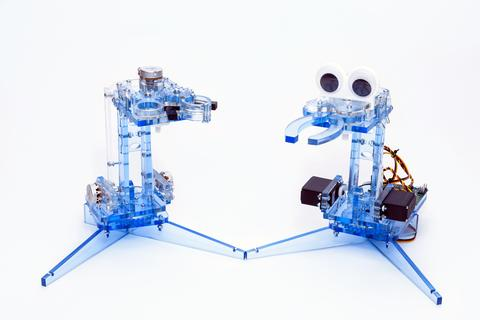
mimicEducationalRobots realized early that a single package would not fit all users needs, so backers have a choice of three packages, each with a unique user in mind.
- The mimicArm kit version includes the robot and manual controller. This version is great for those who want to ease into robotics coding, or those that already have sensors that they’re ready to integrate with the robot. Perfect for beginners and experts, this package is the most affordable option.
- The mimicArm Super Fun Kit is centered around manual mode, with a set of accessories to maximize the fun factor. Users can stack the stacking blocks (included), or program the robot to do it for them. The Great Big Button is also included, and offers additional capabilities for those honing their coding skills (or for those with younger siblings that really want to touch something). “mimicArm Super Fun Kit is targeted towards younger users, but is also a great way for beginners to make coding interesting as well,” says Pipitone.
- The mimicArm Deluxe Kit is the most complete kit offered. Including everything from the mimicArm Super Fun Kit, the mimicArm Deluxe Kit adds the input box and IR Distance Sensor for maximum interactive possibilities. The inputBox incorporates buttons, a microphone and other sensors, and a microSD card. “Programmable with both mimicBlock and Arduino, the Deluxe kit really expands the possibilities. With this kit the user can truly program their own interactive robot,” says Pipitone.
MimicArm is a great educational tool, and users can be a part of it now by backing mimic on Kickstarter. According to Pipitone, „We’re teaching those who will deliver the personal robot of the future. We’re still working on flying cars and jet packs.“
For more information, please visit: http://www.mimicrobots.com/.
OmniJoy is a multipurpose Raspberry Pi-powered robot controller and gamepad
Durham, North Carolina – January 3, 2017 – For Immediate Release
Cerulean Submergence today launched a Kickstarter campaign for
OmniJoy, an open source, handheld, battery-operated, multi-function
controller powered by a Raspberry Pi Zero.
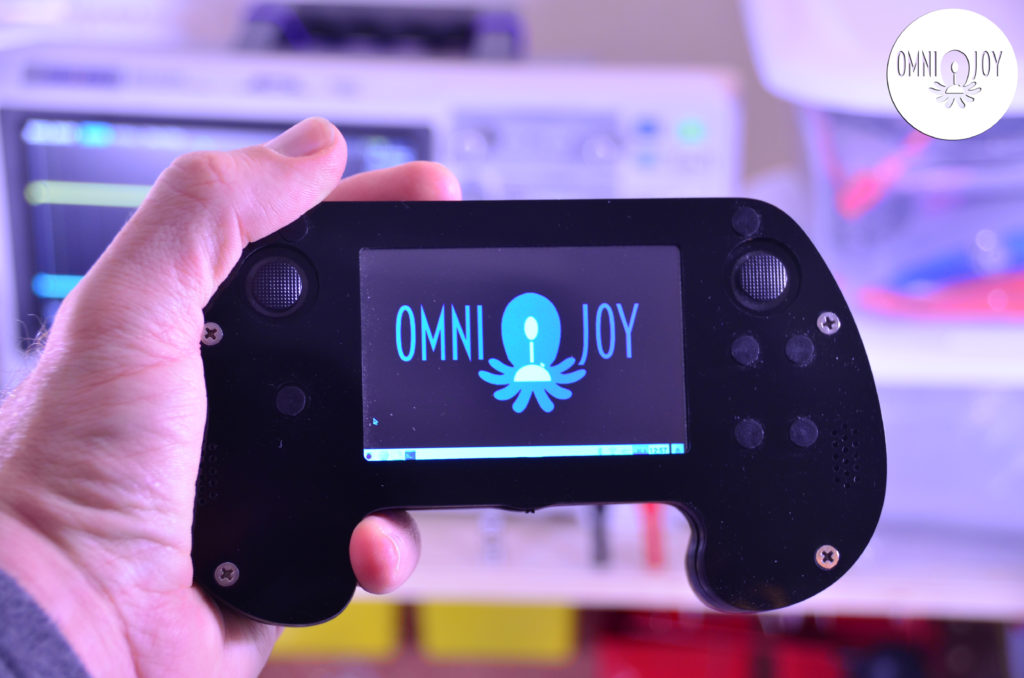
“I was looking for an all-in-one device that could control a variety of
devices while remaining portable and hackable,” said creator of OmniJoy,
Chris Lathan. “I couldn’t find anything I liked, so I designed my own.” As a geek, an engineer, and a maker, Lathan has worked in a variety of engineering roles for the past 15+ years. He fused his extensive mechanical and electrical engineering knowledge to create OmniJoy to fill the void he found in the market for configurable controllers.
OmniJoy features a custom printed circuit board that integrates all of the components Lathan felt a controller needed. OmniJoy consists of two analog joysticks, two shoulder scrolling wheels, a face-mounted navigation switch and six buttons that are all software configurable. The integrated 3.5” touchscreen display can be used to create any additional controls, and a full-size USB-A connector simplifies expandability. An on- board Arduino-compatible processor provides real-time IO to give low latency when precise timing is critical. Other features like the high frame rate display, integrated audio, and room for two large batteries make it excellent for gaming as well. The components are well supported by the maker/Raspberry Pi community.
While the circuit board is usable alone, OmniJoy is offering its Kickstarter backers several other options, from a case with 3D-printed handle grips to a fully-loaded robot-ready version featuring handcrafted Bolivian Rosewood grips. The case is a laser cut stack-up that makes modifications simple. OmniJoy’s grips are available in bespoke Bolivian Rosewood.
“We wanted it functional, hackable, and good looking,” said Lathan. OmniJoy is fully programmable and comes with all the configuration files, drivers, and source-code you need to get started. It can be used as-is, as a portable, handheld, Raspberry Pi-based Linux computer. By adding additional software or programming it, OmniJoy can control widgets, robots, and even your home. It can also be used as a portable RetroPie device.
The ways you can use OmniJoy are endless! We can’t wait to see what our users come up with!
TyroBot, the DIY Humanoid Robot Kit Launches on Kickstarter
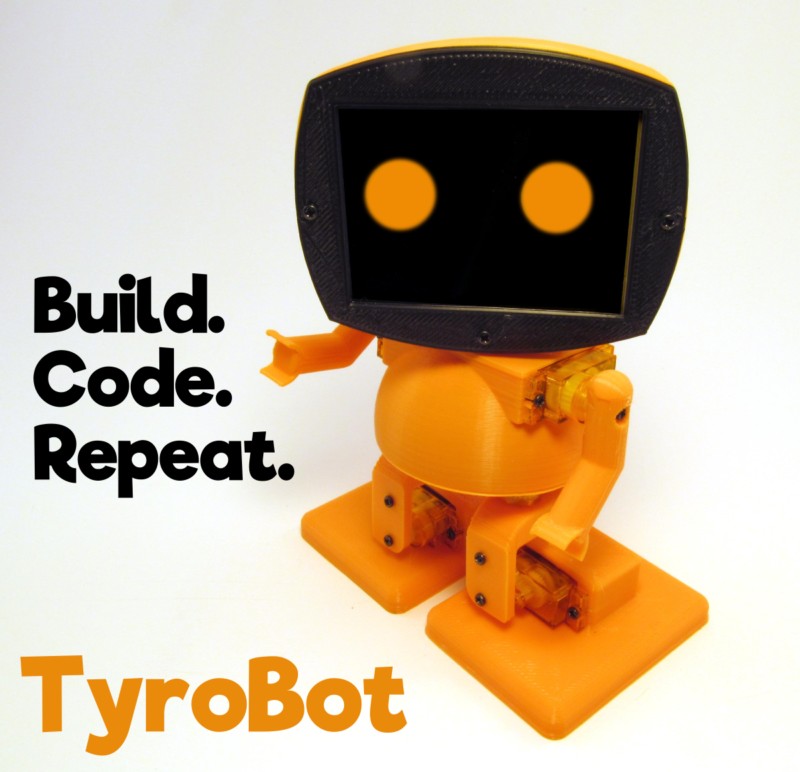
Buffalo, MN: Tyro Electronics, an educational robotics an electronics company founded by Tyler Spadgenske, just launched TyroBot on Kickstarter. TyroBot is a 3D printable do it yourself humanoid robot kit aimed at getting people of all ages and experience levels started in robotics and programming.
TyroBot can be assembled in an afternoon with only a screwdriver and a computer. TyroBot is available in two different models:
- The Maker’s kit includes all the electronics and components you need to build a TyroBot, but you must 3D print the plastic parts yourself. That can be done on any 3D printer with a bed size of at least 100mm^3.
- The complete kit includes everything you need to build a TyroBot except a screwdriver.

TyroBot’s brain is Tyro Board, a custom electronics controller board with a 32 bit ATSAMD21 microcontroller, WiFi, accelerometer for detecting orientation, rechargeable lithium ion battery and two expansion ports for further customization. Tyro Board supports 7 servos, 4 for walking, 2 for arms, and a head servo. On the reverse side of Tyro Board is a 2.8in TFT touchscreen display for programming and playing with TyroBot without the use of a computer.
Once TyroBot is built, flip the switch and TyroBot is operational. Using the built in software, you can make TyroBot walk forward, backward, left and right without ever having to plug him into a computer.
When you are ready for something more advanced, connect TyroBot to a computer and follow easy programming tutorials to make him do more advanced maneuvers by programming him in Arduino with our open source libraries.
With TyroBot’s built in WiFi, the user can also make TyroBot send tweets to Twitter, email, or do anything supported on the IFTT network.
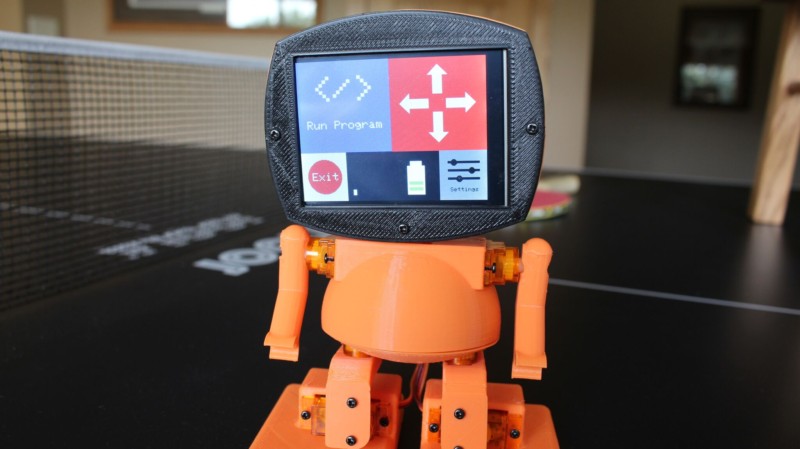
About Tyro Electronics LLC
Tyro Electronics is an educational robotics company founded in 2016 by 17-year-old Tyler Spadgenske.
Tyro Electronics started out by selling parts to make retro game emulators but has moved into selling DIY Kits with the release of TyroBot. Tyler Spadgenke is a student who has built countless electronics and robotics projects, including a Smartphone, Home Monitoring System, and a Smart Drawer.
Links
Kickstarter: https://www.kickstarter.com/projects/tyroelectronics/tyrobot-diy-humanoid-robot-kit/
Project Development: https://hackaday.io/project/12275
Project Source Code and Design Files: https://github.com/TyroElectronics/TyroBot
ICON Corp. Toy Robot to Teach Programming to Infants and Toddlers
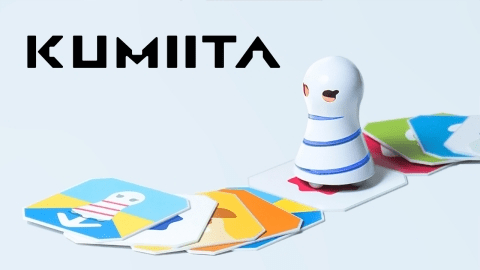
TOKYO–(BUSINESS WIRE)–On April 20th, 2017 (Thu.) ICON Corp. will begin a crowdfunding campaign for KUMIITA, an educational toy designed for 0 to 3 year olds to teach them the concepts of programming.
Kickstarter project page at https://goo.gl/MLkbjM.
By providing a language-less and hands-on experience in the form of a puzzle game, children will be accustomed to programming from a young age. KUMIITA cultivates the basic thinking patterns and logic behind programming in children by allowing them to physically assemble command panels and see how the resulting programs are executed – and why they fail at times, as well. Failed programs can also be fixed by rearranging the panels in various ways, allowing children to figure out new solutions for themselves.
KUMIITA is played by placing down panels which the robot will roll over, following its path ahead. The robot scans each panel and executes different commands to change its color or direction, play a musical instrument, or make animal sounds.
The ICON Outlook
Through cultivating a rich culture of product development that has led us to solutions for searchable, encryption protected data systems, ICON Corp. will soon reach the 20th anniversary of our founding. The KUMIITA project represents a confluence of technical expertise and free thinking to realize the development, introduction, and furthering of new ideas under the banner of „well-being through technology“ that we have strived for since our inception.
To realize a prosperous future through technology, we have taken a stance of total integration, to include not only our programming software, but hardware products and services. And now we are venturing to build opportunities for children so that they may enjoy programming in the effort to accelerate the creation of new ideas, and value that will ultimately carry the future forward.
KUMIITA on Kickstarter
The Kickstarter campaign will run from April 20th through May 20th with a project funding goal of $30,000. For full details concerning the campaign including pledge rewards, please see our project page at https://goo.gl/MLkbjM.
Kuri – A First-of-Its-Kind Home Robot Announced at 2017 International Consumer Electronics Show (CES)
Designed with personality, awareness, and mobility, Kuri enhances life at home and helps people connect
Mayfield Robotics , a Bosch startup out of Redwood City, CA, at CES proudly unveiled Kuri, an intelligent robot for the home. Kuri is designed with personality, awareness, and mobility, and adds a spark of life to any home. Priced at $699, Kuri is available for pre-order in the U.S. with a $100 deposit starting today at heykuri.com.
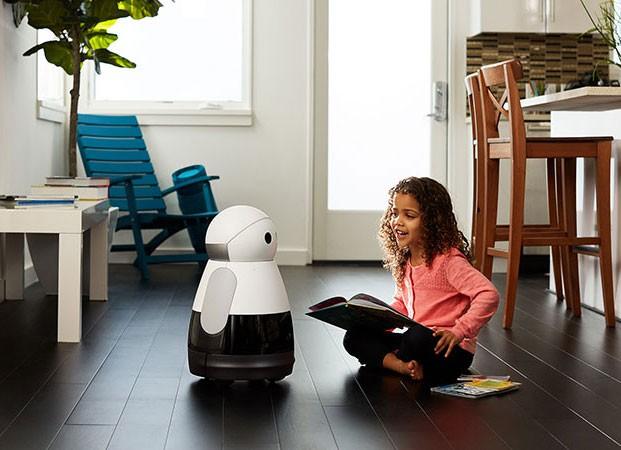
Kuri is built to connect with you and helps bring technology to life. Kuri can understand context and surroundings,recognize specific people, and respond to questions with facial expressions, head movements, and his unique lovable sounds. Like many adored robots in popular culture, his personality and ability to connect are his greatest attributes.
“For generations, people have dreamed of having their own personal robot in the home, and we’ve been focused on making that dream more of a reality,” said Sarah Osentoski, COO and co-founder of Mayfield Robotics. “We’re proud to introduce Kuri to the world and can’t wait to see how he touches the lives of everyone, ranging from parents and children to early technology adopters.”
Behind his clean design, Kuri is powered by serious hardware & capabilities:
- A built-in 1080p camera so you can check-in on the house or pets while you’re away;
- A 4-Microphone array, powerful dual speakers, and wifi + Bluetooth connectivity, so he can play music, read the kids a bedtime story, or follow you around playing podcasts while you’re getting ready for work;
- Various sensors for mapping and detecting edges and objects so he knows where he is, and so you don’t have to worry about him bumping into that chair you forgot to put away, or driving down stairs;
- Easily programmable tasks and IFTTT capabilities to connect within modern smart homes
- Hours of battery life, and when it’s time to refuel, he simply returns himself to his charging dock for a quick charging nap.
“While insanely cute on the outside, Kuri contains serious technologies on the inside that represent the latest developments in smartphones, gaming, and robotics,” said Kaijen Hsiao, CTO and co-founder of Mayfield Robotics. “We hope Kuri introduces people — especially kids — to the power of technology and can inspire a new world of possibilities for their future.”
“I’m excited to finally share the work we’ve done,” said Mike Beebe, Mayfield Robotics’ CEO and co-founder. “We have an incredible team that’s focused on a single dream: home robots done right.”
Kuri is 20” tall, weighs about 14 lbs, and includes an app for iOS and Android for setup and controlcapabilities. Mayfield Robotics plans to ship the first Kuri robots for Holiday 2017.
###
About Mayfield Robotics
Mayfield Robotics is the maker of Kuri, a new kind of intelligent home robot. Born out of the Bosch Startup Platform, the company is a wholly owned subsidiary of Robert Bosch North America Corporation. Founded in 2015 by Sarah Osentoski, Kaijen Hsiao and Mike Beebe, the company is based out of Redwood City, California. For more information, visit www.mayfieldrobotics.com, and to pre-order Kuri, visit www.heykuri.com.
uArm Swift: Multi-use Desktop Robotic Arm for Everyone
In 2014 UFACTORY built the first open source desktop robotic arm, ushering in a new era of affordable desktop robotic arms for consumers. uArm is an Arduino-powered desktop 4-axis parallel-mechanism robot, easy to use, has multiple accessories and open sourced. In Jan 2014, uArm went on Kickstarter and became famous overnight, leading to an exclusive interview with WIRED. A standout quote from the piece: “Thirty years ago Bill Gates promised to put a computer on every desk in America, an ambitious sentiment echoed by Wang and company … The most innovative aspect of the entire project is probably the concept of putting a robot arm on your desk”.
As the robot arm is moving to various industries, its users have expanded from relatively minority geeks to robot lovers. The demand for better and easier user experience is increasing.
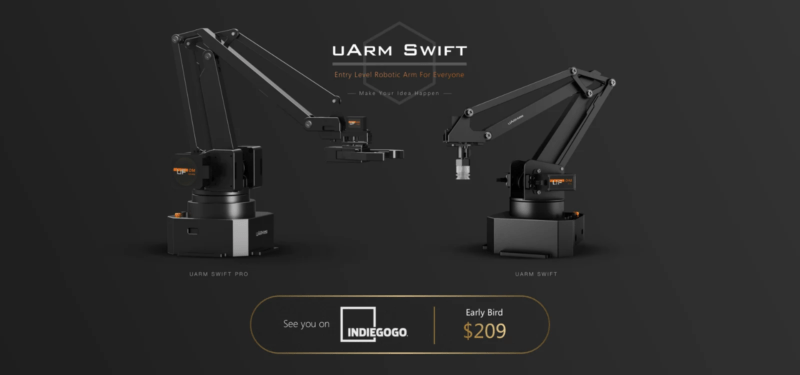
January 23, 2017, UFACTORY returns again, announcing two robotic arms in uArm Swift Series. Swift is intended to highlight the elegant texture of the fuselage, lightweight and portable form and flexible movement, just like a swift. This series has uArm Swift and uArm Swift Pro.
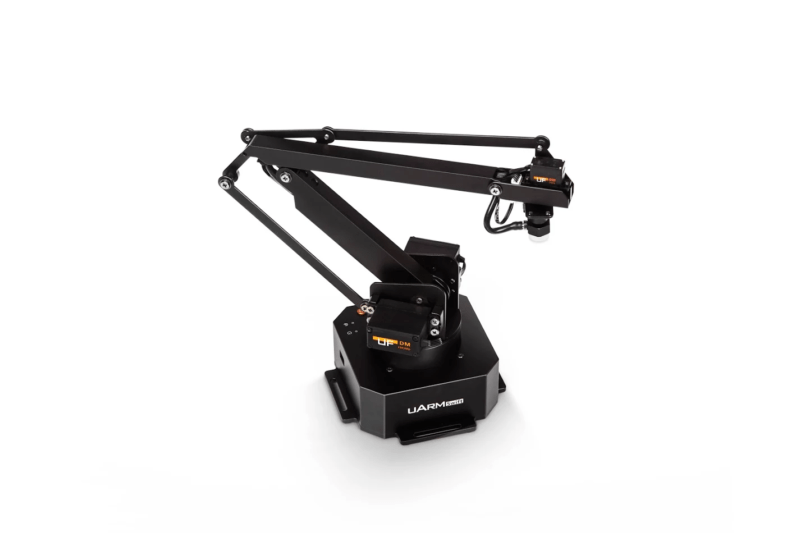
- Hardware Upgrades
Performance improvements
1.Precision improvement
uArm Swift enhanced the control algorithm and increased the accuracy by 50%, from 1cm to 5mm.
uArm Swift Pro adapted self-designed reducer. Working with a high-precision stepping motor, uArm Swift Pro minimizes gear gap, improves joint accuracy, and is more compact. The built-in 12-bit magnetic encoder and motor forms instant position feedback, achieving closed-loop control, and improves the accuracy to unprecedented 0.2mm, perfectly performs 3D printing and laser engraving.
- Working scope improvement:
uArm Swift Series improves mechanical arm structure and increases working range by 20%, covering the working area of an entire A4 paper.
- CPU upgrade
uArm Swift Series upgrades the main board. We choose Arduino MEGA 2560, which is nearly 10 times larger in the storage space compared to the previous UNO edition.
- Accessories enhancements
uArm Swift Series has 4-axis, whether equipped with fixtures or suction head, the end of uArm can freely steer, and the replacement of accessories requires less than 30 seconds.
uArm Swift/uArm Swift Pro have a built-in socket for selected Seeed Grove modules.
uArm Swift Series can be equipped with a smart car, the uCar. uCar is a mobile open-source car, with infrared avoidance, trajectory planning functions.
uArm Swift Series adapts CNC integral forming process, and the whole body is matte black. uArm Swift looks has a more minimalistic design. The aluminum body is light and stable, enhancing the overall rigidity.
Compared with the previous version, uArm Swift series redesigned the base, inserted the mainboard and added power button, function switching button, play button and menu button. The new indicator light shows the current operation mode and status of uArm Swift.
- Software upgrade
uArm Swift Series support PC + mobile control.
Software upgrade -uArm Studio
uArm Studio is a brand new cross-platform robotic arm control software. It has integrated offline learning, graphical programming and instant control functions, manipulate the robotic arm to finish complex tasks.
- Teach & Play Offline Learning Mode
Teach uArm Swift by your own hand to learn move, gripping, dropping, and save them with just a click to replay on Blockly mode. uArm Swift can also sync offline learning data once connected.
- Blockly-based graphical programming
Blockly is a web-based visual programming tool, allowing users to program without needing to code The software is designed to be so simple that even even preschool children could create a program easily. Detailed tutorial will be provided for your quick guide and interesting secondary development.
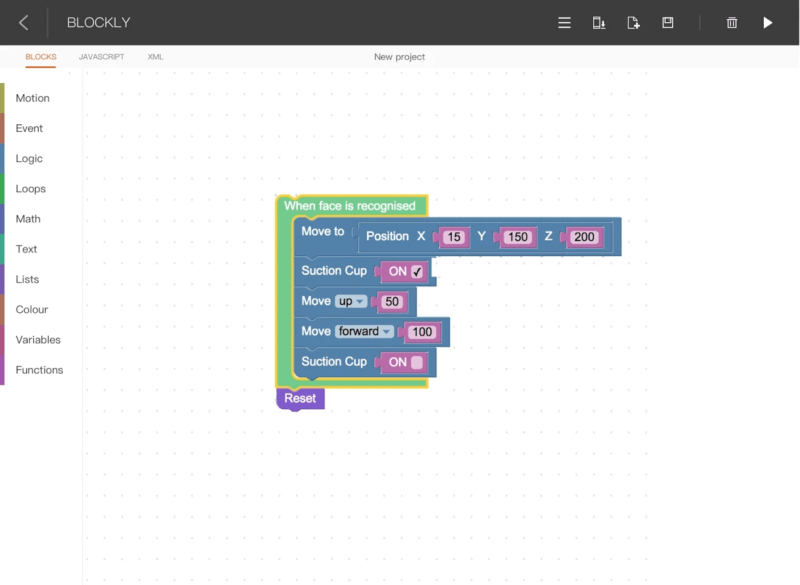
- Instant Control
uArm Studio has combined control of keyboard and mouse. Developers may use keyboard hotkeys and mouse simultaneously to control move, gripping, and dropping of the robotic arm, and it supports customize hot keys.
After connect with LeapMotion, users of uArm Swift may use their own hand to control gesture such as move, gripping and dropping etc.
Software upgrade –
APP-uArm Play
Robotic Arm has built-in Bluetooth module, simply connect your smartphone with uArm Play to remote control your uArm Swift or uArm Swift Pro.
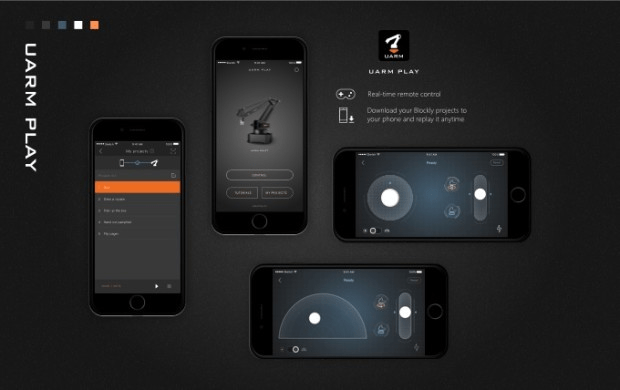
Your smartphone can also work as an external actuator, download and run a program from Blockly.
UCS
UCS, also known as uArm Creator Studio, which is a open sourced developer tool developed by UFACTORY. UCS has integrated graphical programming and coding, to achieve features such as rapid development, visualize and easy sharing.
- Rapid Development
With numerous commands of UCS, developers don’t need to construct programming environment.
For programming developers, UCS is a rapid development tool, developers doesn’t need to construct programming environment, any interface of the whole system supports Python script, all variables can be sharing between visual programming and coding which means you don’t need to copy setting each time.
- Built-in Robotic Vision
UCS has integrated complex robotic vision function, just need to connect with the camera, so the uArm can “see” and adapt to different environment.
The camera can instantly locate, memorize, recognize and track 3D space position of objects.
3.Easy Sharing
Every creator will be able to save their own work as .task file format through the UCS programming, and it supports one click sharing to the official website of UFACTORY or Reddit Community, copying scenario in just one click on other robotic arms.
The uArm Swift Pro is a “Open Sourced” design concept with more freedom, simplicity, and functions. This is a whole new open platform came from developers, back to developers, and still that Open Source Robotic Arm. We just can’t wait to become your comprehensive desktop assistant!

